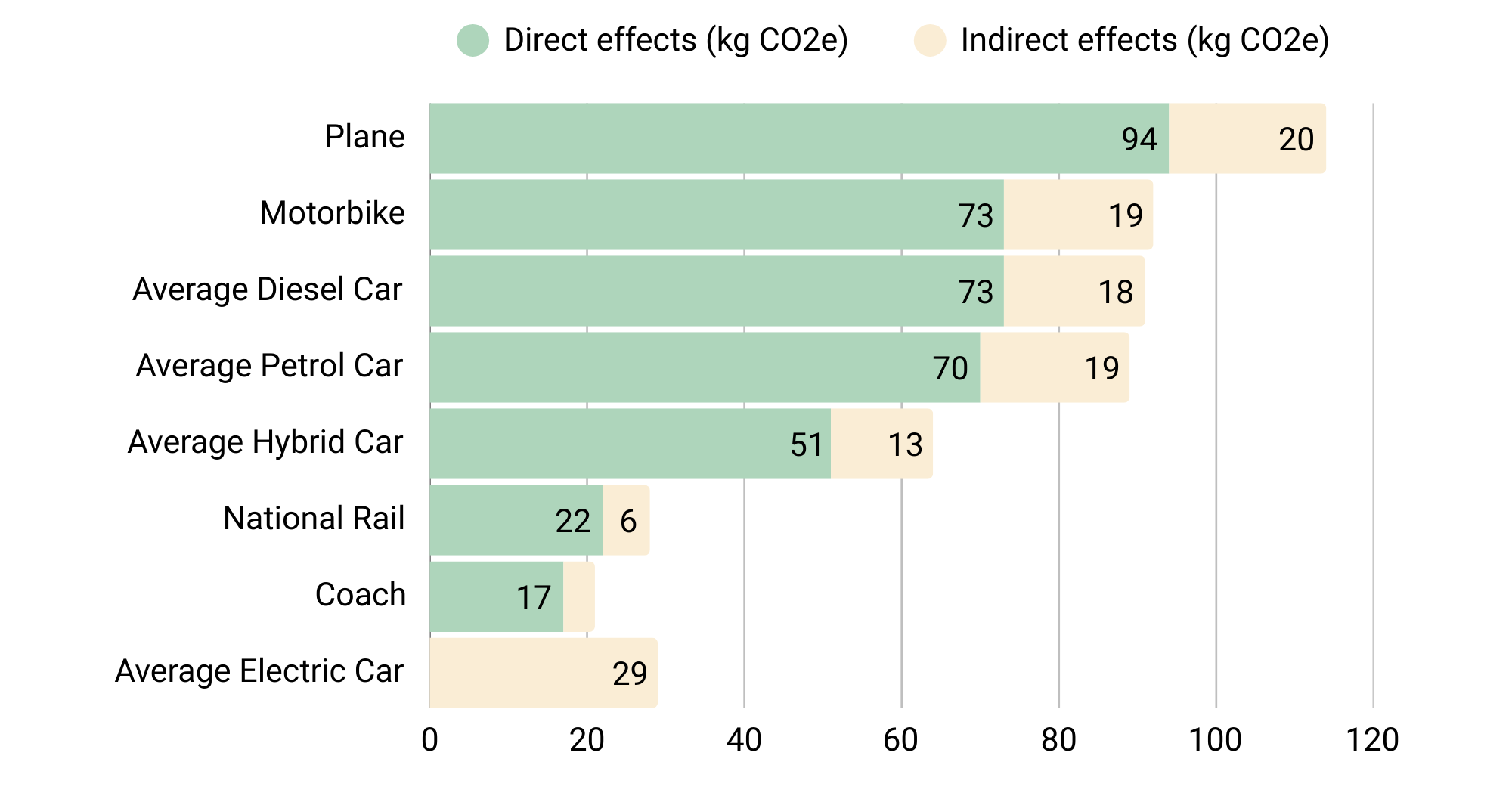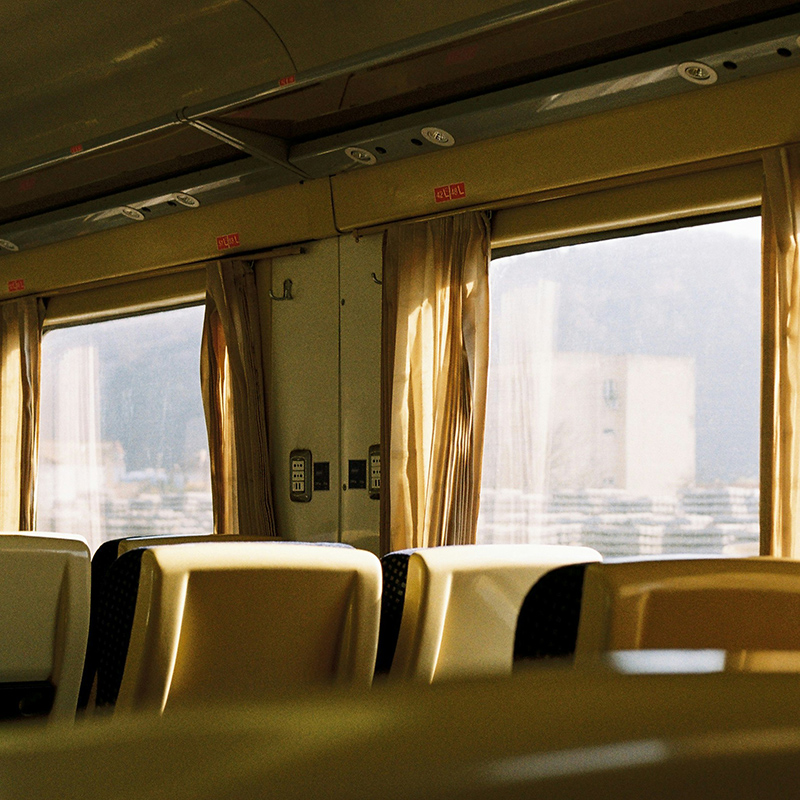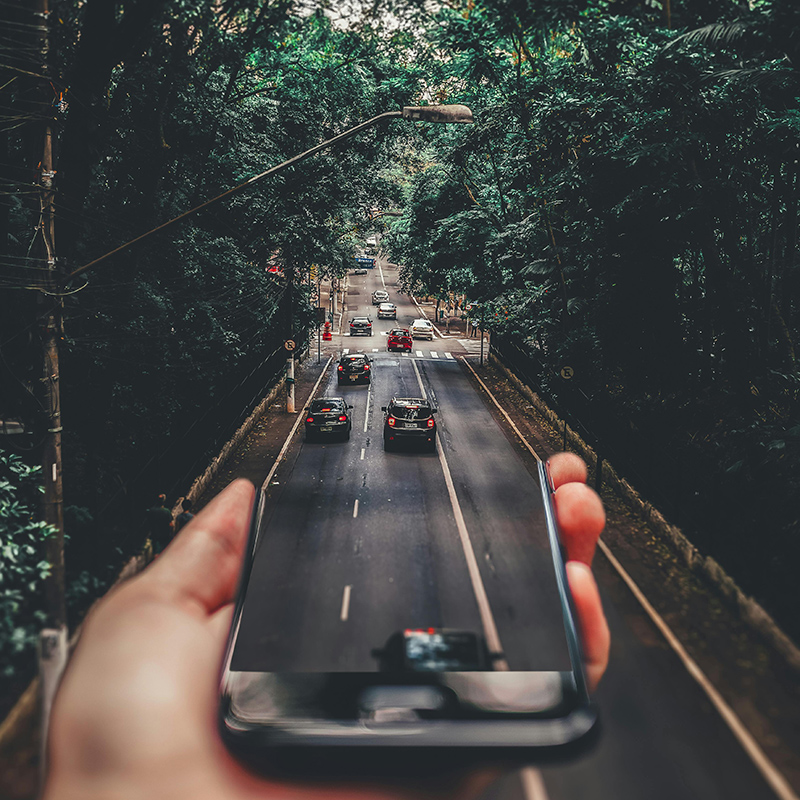Transport produces about 14% of global greenhouse gas emissions, pollutes our air, ground and water, and impacts our health. We can make a difference, through our business travel choices – avoiding unnecessary travel, driving and flying less and using more public transport – and by pushing for transport solutions which are better for the planet and people.
The following resource outlines what you can do to both understand your business travel impacts and take action to reduce them. It was developed by Julie’s Bicycle under the BFI’s Sustainable Screen ‘beyond production’ programme for BFI National Lottery funded organisations and the wider sector.
Summary
Before you start: Key things to consider
- Think about your travel impacts from the start. Face-to-face interactions are essential for culture, our well-being and way of life. However, unnecessary travel can be avoided and travel impacts reduced if you consider travel impacts from the start, in business, event and travel planning and decision-making.
- How you travel makes a difference. Different types of travel have different levels of impact – driving, especially with just one person in the car, and flying have the highest environmental impact. Being aware of the impacts of different types of travel and measuring and tracking business travel impacts, will help you understand the impact of your travel choices over time.
- Factor in fairness, accessibility and inclusivity to make sure the changes you make on business travel don’t create barriers e.g. for people with disabilities, health issues or care responsibility.
Taking action: Practical steps for change
- Measure and track your business travel impacts – to help identify where your biggest impacts lie, inform your actions and see what difference they make.
- Develop your business travel policy – this can take different forms e.g. a standalone sustainable travel policy, a broader travel policy with sustainability ‘built in’ or a few key commitments or principles in a broader environmental policy. Whatever form it takes, it should be based on an ‘avoid-reduce-replace’ approach.
- Take a fresh look at offsetting – avoid carbon offsetting as a route to claiming ‘net zero’ or carbon neutrality. Focus first on avoiding and reducing impacts. If you want to compensate for unavoidable travel impacts, consider alternatives such as donating a percentage of your travel budget to community environmental initiatives.
- Communicate your efforts internally and externally – effective communication is essential to behaviour change – at work, at home and on a wider sector level.
Introduction
Business travel can be a significant source of impact for the screen sector, in particular given the level of international working and networking. It is also an area where organisations tend to have more control and influence (especially for those who don’t own or control the spaces they operate from), in particular in terms of decision-making (which events you go to, who goes where, where you hold your events) and what you do or don’t pay for (what travel options are available to those whose travel you pay for).
- Transport is the highest emitting sector in the UK, producing 26% of total domestic greenhouse gas (GHG) emissions – over half of which is from car travel. It also contributes to air and noise pollution and can cause significant health issues.
- Travel and transport makes up about half of a film production’s emissions, according to a study by the BFI.
- Business travel made up 17% of 2023-24 emissions reported by the screen sector ‘beyond production’ – plane travel made up 57% and train 38%.
-
Meeting people face-to-face can be essential for building relationships and business connections, and sharing knowledge. It’s vital to the screen sector in many ways. However, emissions and other pollution from air and ground transport can add up quickly, so it’s essential to consider how you can meet your business needs, while reducing business travel impacts. A set of questions or a ‘decision tree’ can support planning and decision-making around which events – meetings, conferences, training, festivals – you go to where, how many people need to go and how they get there.

View the decision tree in PDF format.
You might find a travel booking service helpful. They can help streamline bookings, track your carbon footprint, and help enforce travel policies from the start to ensure staff are supported to make sustainable travel choices.
If you run events, there are a number of considerations, depending on whether you run them in your own building/s or workspace/s or a host venue:
- How easy is it to get to the venue by public transport?
- If not directly on a public transport route, can you organise a shuttle bus or shared car journeys from the closest station to the venue?
- What can you do to promote lower-impact travel options for getting to the venue?
- Can you align event start and end times with public transport timetables?
- Can you offer options for people to join virtually?
- What are the environmental credentials – of the venue and/or for the event – and are they visible and well-communicated?
If you provide travel grants for people to go to events, consider the following:
- What can you do to raise awareness of travel impacts with people applying for and awarded funding and to promote lower-impact travel options?
- What are the environmental credentials of the events you fund travel to, and are they visible or communicated? How you travel makes a difference.
-
If you do need to travel, it’s important to be aware of the impact of different types of travel. The ‘sustainable travel hierarchy’ below, gives an overview from lowest to highest impact, with considerations for each type of travel.
Type of travel and considerations
1. Active travel (walking, wheeling, cycling)
- Benefits physical and mental wellbeing.
- Avoids traffic, delays, or congestion.
- Consider ebikes or bike hire schemes for longer distances (e.g. Santander Cycles in London, Starling Bank Bikes in Manchester, or Lime Bikes) and use the National Cycle Network to plan your route.
- Active travel may not be an option for everyone, in particular people with disabilities or health issues.
2. Public transport
- Work or relax during the journey, often with free WiFi, tables or power plugs.
- Overnight trains can save on accommodation costs.
- Longer-distance public transport may be tiring and stressful for some people.
- Sometimes it can be more expensive, especially if booked last-minute – consider allowing more budget for longer-distance public transport.
3. Electric vehicles (EVs) and hybrids
- If you lease or hire cars for business travel, look for EVs or hybrid vehicles first: EVs produce no direct greenhouse gas emissions. After EVs, hybrid cars are the next best option.
- Look for taxi or transfer services which offer electric or hybrid vehicles or use Uber Green.
4. Cars or motorbikes (petrol or diesel)
- Look at journey and car-sharing options, using car clubs or apps like BlaBlaCar.
- If you lease or hire petrol or diesel cars, consider the fuel efficiency and fuel type of the car. Petrol cars have slightly higher emissions per kilometre but diesel cars have more harmful exhaust particles.
5. Air travel
- Flying is nearly always the most polluting way to travel, and there are very limited viable or widely used alternatives for sustainable aviation fuel.
- Sometimes flying is unavoidable. If this is the case, travel Economy where possible. Compared to Economy class, Premium Economy generates 1.6 times more emissions and Business nearly three times more emissions.
- Some booking sites indicate lower emissions routes – generally due to newer, more efficient planes or fuels.
The following graph shows indicative emissions for one person travelling from London to Glasgow by different modes of transport, based on the Department for Transport’s Journey Emission Comparison’s interactive dashboard. You can use the dashboard to compare other common routes across the UK. Other sites such as EcoPassenger also allow for travel impact comparisons.
Indicative GHG emissions for one passenger travelling London-Glasgow

If you are concerned about flying in particular, see Stay Grounded to get a better understanding of the environmental, human and justice issues around aviation.
-
Travel can open up new opportunities and bring many benefits. Being able to travel for work, especially internationally, is a privilege for the few, which comes with a big environmental cost, felt most by those least responsible.
For example, just 2-4% of the global population flew internationally in 2018, 80% have never flown and just 1% of the world’s population are responsible for 50% of aviation emissions. In addition, some people e.g. with disabilities, health issues and caring responsibilities, can face barriers to certain types of travel e.g. air travel, public transport and slow travel, which may limit their opportunities.
When thinking about your travel policy and how to reduce your business travel impacts, it is essential to factor in fairness, accessibility and inclusivity.
- Ensure you have a process for understanding who has specific issues, needs or responsibilities which impact their ability to travel.
- Allow for flexibility in the travel options available e.g. don’t make slow travel the only option as some people may find it easier to fly to reduce fatigue or time away from home or don’t make public transport the only option, if accessibility is an issue.
- Don’t put a blanket ban on international speakers or contributors to your events, as this might unfairly take away opportunities for creatives and professionals from countries beyond Europe, in particular the Global South.
- Travelling less but having better options for virtual participation and engagement at events can be positive for people who are not able, or easily able to travel, especially longer distances or for longer periods of time. Find out what virtual options there are, and push for solutions which maximise virtual participation and engagement.
Practical steps
1. Measure and track your business travel impacts
The first step is to record and measure your organisation’s travel. Your expense records will usually be the place to start. Start recording business trips (how many people, distance travelled, mode of transport). You can use the Julie’s Bicycle template for recording business travel to get started.

Then work out the associated emissions i.e. the carbon footprint of your business travel (which falls under Scope 3 emissions). You can do this using Julie’s Bicycle Creative Climate Tools. If you use the tools to measure other sources of impact e.g. energy use, waste, audience travel, you can also see how much business travel contributes to your overall footprint.
Business travel is a large portion of emissions, and flights are the biggest contributor
Average emissions breakdown reported by the screen sector ‘beyond production’ using Julie’s Bicycle Creative Climate Tools.
Business travel
All other emissions
Measuring your business travel emissions can help identify priorities and inform action. If you update the data on an annual basis, it will also help you track the difference your actions make in terms of reducing emissions.
Breakdown of the 17% business travel emissions
2. Develop your business travel policy
Your travel policy can take different forms e.g. a standalone sustainable travel policy, a broader travel policy with sustainability ‘built in’ or a few key commitments or principles in a broader environmental policy. The BFI, for example, have a ‘Sustainable Business Travel Policy’ which integrates sustainable choices with procurement and booking guidance. Whatever approach you take make sure it is:
- relevant to size, scale of your organisation and the nature of your activities
- based in understanding of your business travel impacts
- built on the ‘avoid-reduce-replace’ hierarchy
- clear, agreed and communicated
- accompanied by appropriate procedures e.g. a set of questions to factor travel impacts into planning or an expenses procedure which favours lower-impact travel
When working out your policy and supporting procedures:
- Engage with your employees, via an online survey or workshop, to understand their experiences and what they’d like to see.
- Ensure it links into your broader business and environmental plan, and clearly explains the ‘why’.
- Create and share a draft policy internally, or trial out new processes and get feedback before rolling out organisation-wide changes.
- Remember to communicate throughout the process, because behaviour shifts take time and persistence.
- Continue to monitor and measure your progress to understand what’s working and where you can improve.
- Consider sharing your policy publicly.
For further guidance, see Culture for Climate Scotland’s guide to creating a travel policy.
Sample policies or guidance
-
The Gallery Climate Coalition’s Climate Conscious Travel Policy is available on their website and includes:
- setting an annual carbon budget for business travel.
- an easy-to-use decision tree.
- a ‘zone map’ of Europe that outlines travel permitted depending on travel time.
- ‘criteria for air travel’, where at least four criteria must be met to travel by air.
-
The University of Oxford’s Travel Policy was developed as part of its wider Environmental Sustainability Strategy, and is based on an approach of balancing cost, environmental impact, and diversity, equality and inclusion.
-
Creative Scotland has taken an integrated approach and made sustainability part of their broader business travel policy. It is hosted on their internal intranet and accompanied by videos and training materials. The policy also links to their wider Climate Emergency and Sustainability Plan.
The policy:
- outlines their travel hierarchy across local, national and international travel.
- covers how to communicate the travel policy when travel costs are covered by other organisations.
- includes year-on-year reduction targets, and reports on data from previous years.
- illustrates how employees can check if there is both ‘money’ and ‘GHG emissions’ budget for their travel.
For guidance on writing organisational environmental policies
JB’s Environmental Policy and Action Plan guide3. Take a fresh look at offsetting
Meeting people face-to-face can be essential for building relationships and business connections, and sharing knowledge. It’s vital to the screen sector in many ways. In the past some organisations have used offsetting as a route to claiming carbon neutrality for their business travel.
However, offsetting should only ever be a last resort, once you have done all you can to ‘avoid-reduce-replace’ first. In addition, there are significant issues with traditional offsetting – many schemes do not deliver the promised benefits, and in some cases result in negative environmental and social impacts, and greenwashing is a big issue. There is a growing movement towards alternative approaches to offsetting, compensating for or balancing out unavoidable emissions.

For further information on the pros and cons of offsetting, and alternative approaches, see Julie’s Bicycle guide Putting a Price on Carbon.
We recommend approaches such as Strategic Climate Funds. This approach requires genuine commitment to a significant reduction in travel emissions, coupled with organisations setting aside money to support frontline, community-based climate projects and avoids net zero or ‘carbon neutrality’ claims. For more, see the work of the Gallery Climate Coalition.
4. Communicate your efforts internally and externally
The screen sector has a responsibility to take action to reduce its business travel impacts. Screen sector organisations can also inform and inspire action and wider change by sharing their experience – progress, challenges, opportunities – raising awareness and collaborating on cleaner, greener transport solutions. Communication is key.
Introducing a new travel policy will most likely require a shift in behaviour and the ‘norms’ of travelling. Make sure new policies or procedures are well communicated internally and appropriately resourced, so that people understand the reason for these changes and it’s clear what they mean in practice. Connect your travel policy to your broader aims and values. You might also inspire people to make changes in their personal lives too.

Sharing and communicating your policy and approach externally, and raising awareness can help inspire others across the screen sector, as well as your audiences or the people or organisations you work with, support or fund. HOME Manchester, for example, share their approach to sustainable travel on their website – from business travel and staff commuting to audience travel, including collaboration with local sustainable travel initiatives. The British Council has made a Greener Travel Guide available on its Film Travel Grant Fund webpage, to raise awareness and provide applicants and grantees with information on the practical steps they can take to avoid or reduce travel impacts.
If you are concerned in particular about flying, Stay Grounded’s Reframe Aviation provides guidance on messages and narratives to reframe how we talk about flying and its impact on people and the planet.
By not only taking action to reduce travel impacts, but by also sharing what you are doing and raising awareness, you can have an even bigger positive impact.

This resource was developed by Julie’s Bicycle under the BFI’s Sustainable Screen ‘beyond production’ programme for BFI National Lottery funded organisations and the wider sector.
Authors: Tenaya King, Claire Buckley and Tammy Marrett